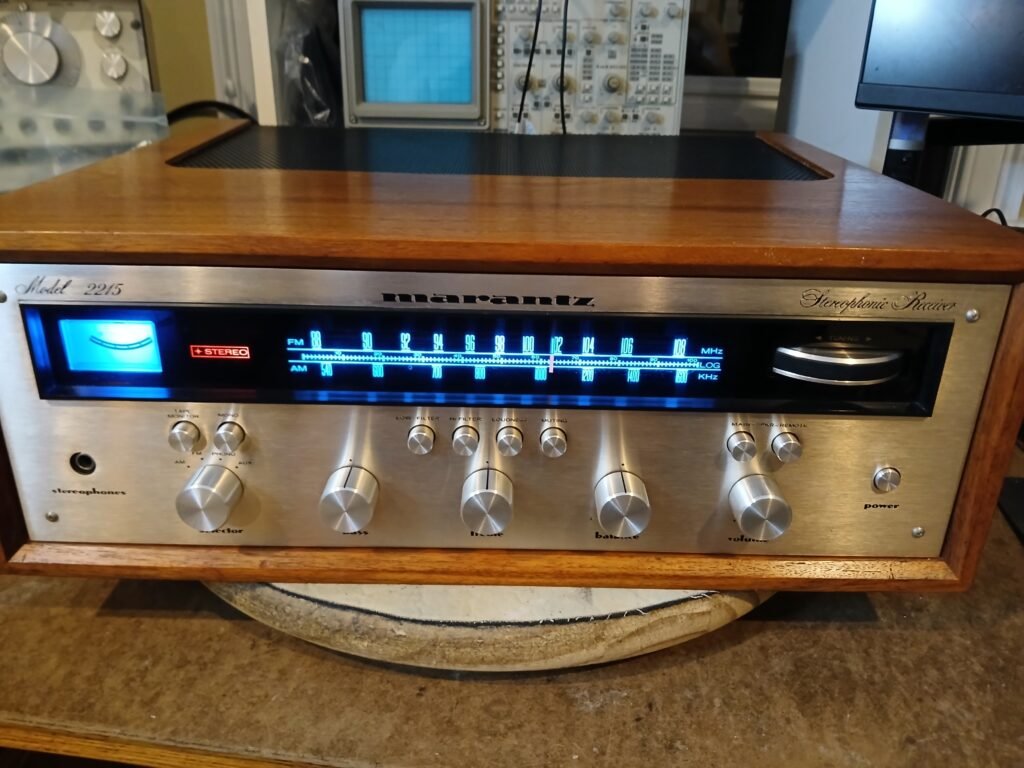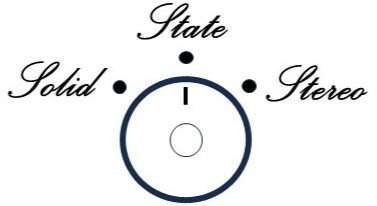Marantz 2215
$700

Examples of interior restoration results (click on photos to expand)
Exterior photos
Blemishes
Restoration notes
Beyond the list of standard restoration steps detailed on the main page, here are some added notes for this unit :
I acquired this receiver from a local collector and friend. It was reported to be working and the cosmetics were very good. Many audiophiles prefer the Marantz 2215 sound over its more powerful brethren and it will drive any set of reasonably efficient speakers without issue.
Of special mention is that this is a “champagne” 2215 with an etched faceplate which Marantz used for the initial production run of several series back in the early/mid 70s. The faceplate finish has a slight golden tinge and the printing is inset vs silk-screened (see photos). While is is possible to “fake” a champagne Marantz by swapping in a reproduction faceplate, I have included 3 photos showing the serial number “4790” which falls in the documented range (1000 to 5999) for 2215 champagne units. One “4790” is on the back panel plus 2 photos of the correct places on the interior chassis where the same “4790” can be seen. The cabinet is period correct (MDF with veneer), but I can’t say if it is original to this receiver. The interior metal cover is pristine, which suggests to me that this 2215 was always in a wood cabinet.
“Champagne” 2215s are fairly rare and this is reflected in the price.
Initial functional testing went well with normal observations of FM out of alignment, sound not quite right, etc.
Looking inside, I could see that previous repair work had been done on the tone and main amplifier boards. The output transistors are originals (no major amplifier failures) and there was no sign of overheating on any boards.
A check of the main amp idle currents showed that the left channel could not be set to the correct level. This continued to be the case after recapping the board. I removed/tested all the left channel transistors/diodes and they were all fine. I next compared resistor impedances (left vs right channels) and saw large differences. Marantz used several 1/2W “solid” resistors in the main amplifier, and these are know to drift. Many I measured were way out of spec. I replaced them all (both channels) with new metal film 1/2W resistors. This fixed the left channel idle current issue which I could now set correctly.
I moved on to the tone amplifier and immediately noted clipping on its output plus a large 120Hz (hum). The previous tech had added caps “in the air” and replaced others on the board. I decided to recap the entire board (and remove the “flying caps”). I found that some caps the tech had replaced were installed backwards. I am guessing the previous tech added the “flying caps” to mitigate the clipping vs finding the source (backwards caps). I then replaced all the known-problematic transistors. Testing once again showed that the clipping issue was now resolved. I turned to understanding the output hum and noted that the star washer was missing from the grounding tie down for this board. While most manufactures solder chassis ground connections, this unit uses eyelets and screws. The star washer is critical to getting a good electrical connection to the chassis, and I assume the previous tech forgot to include it when servicing the tone amplifier board. Putting in a new star washer and firmly tightening the screw eliminated the hum on the tone amplifier output.
Retesting after these main and tone amplifier fixes (using the aux path) verified that the entire audio section was now working quite well.
While recapping the FM tuner sections, I noted a broken Germanium diode on the FM IF board (Germanium diodes have low forward bias and are popular on tuner boards where signal levels are rather low). Though I could push the diode halves together to get correct functionality, a new Germanium diode was installed and the FM section aligned nicely. FM sensitivity, stereo separation and overall sound are very good.
Marantz made accessing the AM/RF board rather difficult, so I decided to leave it as is (no performance issues, not worth the risk of damaging something doing a recap of that board, IMHO).
Final functional testing complete/passed.
Regarding cosmetics, the wood cabinet has some dings and scratches, but I feel it is still in pretty good shape given >50 years of use (see photos). The faceplate has one scratch in the upper right corner. The knobs are clean. The interior “wood grain” finished metal cover is pristine. The previous tech installed blue LEDs behind the dial and meters. I think they look OK, so left them as is.
Bench measurements
The Marantz spec is a bit unclear to me, so I will assume the most demanding interpretation.
15 watts per channel (15 Hz to 50,000 Hz, both channels driving 8 ohms, 0.9% max harmonic distortion)
My results (all with both channels driving 8 ohms, 0.9% max harmonic distortion)
16.5 watts per channel @ 20 Hz (lowest frequency I can source)
21 watts per channel @ 20,000 Hz
18 watts per channel @ 50,000 Hz
Some reference links
hifiengine : https://www.hifiengine.com/manual_library/marantz/2215.shtml
Classic Receivers : https://classicreceivers.com/marantz-2215
